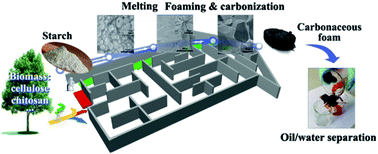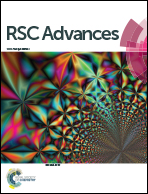A simple strategy for converting starch to novel compressible carbonaceous foam: mechanism, enlightenment and potential application†
Abstract
Preparation of new materials from biomass is good for sustainable development. Carbon/carbonaceous foams (CFs), as important materials widely applied in both military and civil use, are usually made from nonrenewable materials at high temperature (usually over 1000 °C) and high pressure (at MPa magnitude). Although some biomass raw materials have been used, there is still a fascinating issue waiting to be discussed. That is, what kind of biomass would be suitable for making CFs, or what the biggest challenge might be if these raw materials are used. Herein, a CF with advanced compressibility was made from starch with a simple and energy efficient strategy. The product can be made at much lower temperature (below 500 °C) and pressure (∼190 Pa) than conventional strategies. The understanding of the conversion mechanism provides inspiration for the conversion of other biomass into value-added carbonaceous materials. Due to the presence of reactive groups on the surface of the as-prepared CF, the product can be further modified or used as a substrate to prepare composites for catalysis, phase change energy storage, sensors, water purification, and so on. In this work, its potential application in oil/water separation was demonstrated.



 Please wait while we load your content...
Please wait while we load your content...